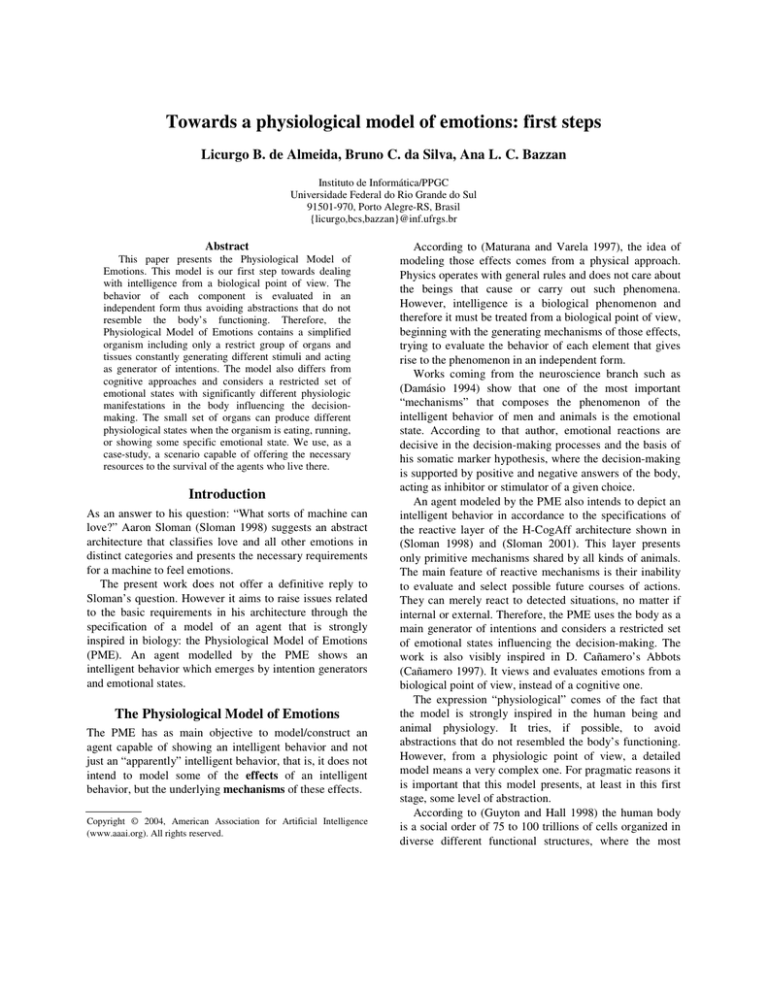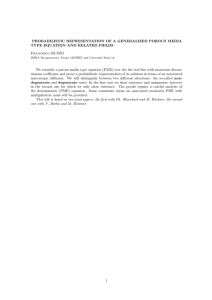
Towards a physiological model of emotions: first steps
Licurgo B. de Almeida, Bruno C. da Silva, Ana L. C. Bazzan
Instituto de Informática/PPGC
Universidade Federal do Rio Grande do Sul
91501-970, Porto Alegre-RS, Brasil
{licurgo,bcs,bazzan}@inf.ufrgs.br
Abstract
This paper presents the Physiological Model of
Emotions. This model is our first step towards dealing
with intelligence from a biological point of view. The
behavior of each component is evaluated in an
independent form thus avoiding abstractions that do not
resemble the body’s functioning. Therefore, the
Physiological Model of Emotions contains a simplified
organism including only a restrict group of organs and
tissues constantly generating different stimuli and acting
as generator of intentions. The model also differs from
cognitive approaches and considers a restricted set of
emotional states with significantly different physiologic
manifestations in the body influencing the decisionmaking. The small set of organs can produce different
physiological states when the organism is eating, running,
or showing some specific emotional state. We use, as a
case-study, a scenario capable of offering the necessary
resources to the survival of the agents who live there.
Introduction
As an answer to his question: “What sorts of machine can
love?” Aaron Sloman (Sloman 1998) suggests an abstract
architecture that classifies love and all other emotions in
distinct categories and presents the necessary requirements
for a machine to feel emotions.
The present work does not offer a definitive reply to
Sloman’s question. However it aims to raise issues related
to the basic requirements in his architecture through the
specification of a model of an agent that is strongly
inspired in biology: the Physiological Model of Emotions
(PME). An agent modelled by the PME shows an
intelligent behavior which emerges by intention generators
and emotional states.
The Physiological Model of Emotions
The PME has as main objective to model/construct an
agent capable of showing an intelligent behavior and not
just an “apparently” intelligent behavior, that is, it does not
intend to model some of the effects of an intelligent
behavior, but the underlying mechanisms of these effects.
Copyright © 2004, American Association for Artificial Intelligence
(www.aaai.org). All rights reserved.
According to (Maturana and Varela 1997), the idea of
modeling those effects comes from a physical approach.
Physics operates with general rules and does not care about
the beings that cause or carry out such phenomena.
However, intelligence is a biological phenomenon and
therefore it must be treated from a biological point of view,
beginning with the generating mechanisms of those effects,
trying to evaluate the behavior of each element that gives
rise to the phenomenon in an independent form.
Works coming from the neuroscience branch such as
(Damásio 1994) show that one of the most important
“mechanisms” that composes the phenomenon of the
intelligent behavior of men and animals is the emotional
state. According to that author, emotional reactions are
decisive in the decision-making processes and the basis of
his somatic marker hypothesis, where the decision-making
is supported by positive and negative answers of the body,
acting as inhibitor or stimulator of a given choice.
An agent modeled by the PME also intends to depict an
intelligent behavior in accordance to the specifications of
the reactive layer of the H-CogAff architecture shown in
(Sloman 1998) and (Sloman 2001). This layer presents
only primitive mechanisms shared by all kinds of animals.
The main feature of reactive mechanisms is their inability
to evaluate and select possible future courses of actions.
They can merely react to detected situations, no matter if
internal or external. Therefore, the PME uses the body as a
main generator of intentions and considers a restricted set
of emotional states influencing the decision-making. The
work is also visibly inspired in D. Cañamero’s Abbots
(Cañamero 1997). It views and evaluates emotions from a
biological point of view, instead of a cognitive one.
The expression “physiological” comes of the fact that
the model is strongly inspired in the human being and
animal physiology. It tries, if possible, to avoid
abstractions that do not resembled the body’s functioning.
However, from a physiologic point of view, a detailed
model means a very complex one. For pragmatic reasons it
is important that this model presents, at least in this first
stage, some level of abstraction.
According to (Guyton and Hall 1998) the human body
is a social order of 75 to 100 trillions of cells organized in
diverse different functional structures, where the most
Figure 1 – Body’s conceptual diagram (arteries and veins not included).
important structures are called organs. Each internal
functional structure or organ has a role in the maintenance
of the internal environment. Thus, it is easy to perceive
that to model the functioning of each cell individually is a
very complicated task. Even with certain level of
abstraction, the task of modeling the functioning would be
complex and costly from the computational point of view.
This is exemplified by the proposal of D. Harel (Harel
2002). He estimates at least 10 years of work by many
groups with diverse backgrounds to construct a full, trueto-all-known-facts 4-dimensional model of the C. elegans
nematode worm. And this is possible only because the
worm is transparent, its cell lineage is invariant, and the
total number of cells is relatively small. However, a
reasonable alternative would be to detail the functioning of
each organ or tissue formed by these sets of cells.
In the PME the idea of a cell gave place to a set of cells
forming organs or tissues and, therefore, all the activities
carried out by each cell are summarized in the functioning
of the organ or tissue of which it is part. Each one of these
organs and tissues has an important role in the homeostasis
of the body, either supplying or generating products for it.
One of the most important concerns of the PME is
exactly the emotions, or how an agent modeled by the
PME shows these emotions. One problem faced is the high
number of controversies about emotions. For instance,
(deSousa 2003) shows the enormous diversity of
approaches for this subject, both for the “psychological”
and for the “biological” one. Since the PME follows a
biological approach, the emotions were also tackled from
the biological point of view. The model is based on the
idea which appeared in (Ledoux 1996): a limited number
of emotions do, in fact, have significantly different
manifestation in the body. The great variety of emotional
states is obtained by the interaction of these states with
cognitive aspects. The real interest of the PME is the set of
inherent primordial emotions (plus its physiological
manifestation).
An agent that is concerned with how to obtain food, to
flee from enemies, and to find sexual partners does not
need to pursue rich philosophical aspirations. Also, it does
not require complex emotional states such as envy or
guilty. For these reasons some emotions are unnecessary.
Besides, this kind of emotion does not belong to the first
layer of the H-CogAff architecture. The emotional states
from the first layer are denominated by Sloman as primary
emotions. These are primitive emotional states like being
startled, terrified, sexually stimulated, etc.
The Implementation of the PME
The initial concern of our work was the theoretical basis of
the PME, e.g. how to include the work of the diverse
researchers that had served as basis for it. In its current
stage, the model already possesses a complete specification
of the intentions generator of the body, as it is shown in
Figure 1.
As a simplified model of an organism, the PME
includes only a restrict group of organs and tissues which
were found to be necessary to the basic functioning of the
body. For example, (Guyton and Hall 1998) point that the
lymphatic system is an accessory path where the bodily
liquids flow from the interstitial space back to the
bloodstream, avoiding stagnation among cells, since the
veins cannot do it by themselves. However, if the proposed
model has not liquid among cells (and this is the case here
since it has no cells at all) all main functions of the
lymphatic system become of little use. Thus, the systems
which remained in the PME are:
• Respiratory system: responsible for carrying
oxygen from the air to the blood stream and
expelling the waste product of carbon dioxide;
• Digestive system: where the nutrients (in this
case glucose) in absorbed and the waste is
disposed;
• Endocrine system: this is very important to
emotional reactions and sexual behavior;
• Circulatory system: effectively, carries oxygen,
carbon dioxide, glucose and hormones through
veins and arteries to all the organs of the body;
• Urinary system: where the kidney makes up a
filter system for the blood and sending waste
(urine) into the bladder for storage until it can be
disposed;
• Nervous system: crucial in the control of the
systems above.
The range of possibilities opened with this small set of
organs and a body becomes very interesting. After all, each
organ acts as an intention generator, since it needs oxygen
and nutrients to work. The absence of any substrate makes
the organ work improperly, generating different stimuli to
the nervous system. Moreover, the circulatory system,
through the vasoconstriction and vasodilatation of the
arteries, is constantly modifying the amount of substrata
sent to the organs and tissues, due to the variations in the
bloodstream caused by the alteration in the cardiac
beatings. Different physiological states appear when the
organism is eating, running, or showing some specific
emotional state.
The model was designed with two types of primordial
motivations: Survival and sexual motivations. The first
type of motivation comes from the idea that all organs of
the body need energy to work correctly, and to carry out its
functions in the homeostatic balance. Therefore, this
organism is interested in the production of energy to keep
himself “alive”.
As a real organism, every organ of the PME needs ATP
(adenosine triphosphate) to work. According to (Guyton
and Hall 1998) this ATP is obtained through the chemical
reaction of the oxygen with three different types of foods:
glucose derived from the carbohydrates, fat acid derived of
the fats, and amino acid derived from proteins. However,
most of the ATP is gotten from glucose. Then, again for
the sake of abstraction, the agent is only interested in
getting glucose, so that together with the oxygen it can
generate ATP. A part of the model was then specified in
order to get and distribute O2 and glucose through the
organism, to eliminate resultant CO2 and H2O of the
attainment reaction of the ATP and to consume this last
one. This process involves mainly the respiratory,
digestive, circulatory and urinary systems.
The sexual motivations are presented in a very
simplified form and only act as a secondary intention
generator. They are related to the endocrine system, which
is responsible for the production of testosterone and
estrogen, the two sexual hormones incorporated in the
model.
In summary, the PME offers the possibility of
simulating a body with several organs, working in the
same time scale, constantly generating different stimuli in
order to keep a homeostatic balance, as well as a set of
emotions acting directly on the physiology of this body in
order to influence the decision-making.
A Brain to Control Everything
The specification of the body is only the first step of the
PME. Apart from this, it is necessary to define or model a
brain that deals with the information sent by the body. This
is so because a body would be useless if the central control
of this organism were carried out by a completely reactive
brain. The strategy of control adopted in the Physiological
Model of Emotions is the theory of Neuronal Group
Selection (TNGS) or Neural Darwinism proposed by G.
Edelman (Edelman 1992). This theory seeks to explain the
functioning of the mind from a biological point of view,
relating the behavior of neurons to the behavior of the
immune system: a repertoire of antibodies constitute a
population which is selected up and down according to the
presence of viruses and other threats.
It is important to say that the brain of the PME needs to
deal with two concurrent environments. The external one
(where the agent is immersed), and the intern environment
of the agent proper. Thus, there is a number of perceptions
to evaluate. The next step is the creation of distinct
networks of perception: e.g. one for the "hypothalamus"
(to receive stimuli from the body) and a species of "cortex
of external perception" (to deal with the external stimuli).
Although a reactive brain is not desired in the model, at
the neural level reactive processes do occur: this is the
basis of the value system proposed by Edelman. Values are
phenotypic aspects of an organism that were selected
during evolution such as the synaptic changes that occur
during brain development and experiences. For example,
babies grasping objects is a skill developed after trying
random movements and receiving positive and negative
feedback. This enhances the selection of synapses and
groups of neural patterns of activity that lead to appropriate
actions. For the PME, such a value system is needed to
model the implementation of the physiological
manifestations of emotions, since these need to be
triggered in specific situations.
Obviously we are aware of the difficulties posed by
both the modeling of the body and the brain. The
difficulties associated with the former were already pointed
out (Harel 2002). As for the latter, which are even more
challenging, the work of Edelman and colleagues on the
Darwin III and IV artifacts (Edelman and Tonomi 2000)
proves that simple value systems are capable of real-world
behavior. Darwin IV is an artifact which has “`eyes’’ to
track randomly moving targets. Its value system has an
inherited bias that states that “light is better than
darkness’’, i.e. Darwin IV has a taste for light. Neuronal
groups which leads to choice of, say light objects, are
selected up and so Darwin IV is able to pick up light
objects and reject dark ones.
Although it is still a huge step to get artifacts like
Darwin IV to realize more sophisticated interactions (e.g.
those related to the various emotions), values and emotions
are coupled and are central to conscious experience
(Damásio 1994, Edelman and Tonomi 2000). Thus, any
step in this direction, no matter how small, is worth.
Case-Study
We intend to use the PME in a well-know scenario like the
Gridland (Cañamero 1997), a bi-dimensional grid capable
of offering the necessary resources to the survival of the
agents who live there: oxygen and food sources with
glucose. The choice of the scenario was motivated by the
similar aims of the two works, that is, the attempt to
analyze emotions on neurobiological and evolutionary
perspectives. The PME also seeks to depict the
physiological manifestations of emotions in the organism,
as acceleration of the cardiac beating, vasoconstriction and
vasodilatation, and release of hormones in the bloodstream.
This makes the creature depict different internal and
external perceptions, directly modifying its behavior.
The main difference between a PME’s agent and the
Abbots lies in the internal milieu. The internal milieu of
the Abbots is constituted by a set of “bodily states” which
can be of two types – “controlled variables” and
“hormones”. The first one are variables necessary to the
survival of the creature, controlled by homeostatic
processes which keep them in certain range of stability.
The second type, the hormones, are released when the
Abbot have an emotional reaction. Each hormone can
affect several variables, but it has a particular valence with
respect to each of then.
The PME’s internal milieu is not composed by a set of
variables, but by a group of objects, which could do more
than just change their current state. The main advantage of
a group of objects consists in the fact that it can be
expanded and each detail refined. The PME just proposes
the basic structure, the main idea. In a first version, the
PME’s brain sends a message to the muscle (object) to act.
In the future these muscles could be divided in a set of
specific muscles (set of objects), surrounded by a
neurosystem sending and receiving information about
every stimulus between objects and sets of objects. This
applies not only to the muscle but for all other entities in
the model.
Acknowledgments
We are grateful to Roni Quevedo, Renato Zamora Flores
and Márcio da Silveira Rodrigues for the insightful
discussions. Authors partially supported by CNPq.
References
Cañamero, D. 1997. A Hormonal model of emotions for
behavior control. Proc. of 4th European Conference on
Artificial Life, ECAL.
Damásio, A. 1994. Descartes’ Error: emotion, reason and
the human brain. HarterColins Publishers.
Edelman, G. 1992. Bright Air, Brilliant Fire: On the
Matter of the Mind. Basic Books.
Edelman, G. and Tonomi, G. 2000. A Universe of
Consciousness: How Matter Becomes Imagination. Basic
Books.
Guyton, A. and Hall, J. 1998. Textbook of Medical
Physiology. W. B. Saunders Co.
Harel, D. 2002. A Grand Challenge for Computing: Full
Reactive Modeling of a Multi-Cellular Animal In UK
Workshop on Grand Challenges in Computing Research.
Ledoux, J. 1996. The Emotional Brain: the mysterious
underpinnings of emotional life. Simon & Shuster.
Maturana, H. and Varela, J. 1997. De Maquinas Y Seres
Vivos. Editorial Universitaria.
Sloman, A. 1998. Architectural requirements for humanlike agents both natural and artificial. In: Human cognition
and social agent technology. v.19, p. 163-195. John
Benjamin’s Publishing Company.
Sloman, A. 2001. Beyond shallow models of emotion.
Cognitive Processing, v.2, n.1, p.177-198.
de Sousa, R. 2003. Stanford Encyclopedia of Philosophy:
emotions. http://plato.stanford.edu/entries/emotion








